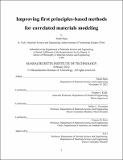Improving first principles-based methods for correlated materials modeling
Author(s)
Bajaj, Akash
DownloadThesis PDF (84.28Mb)
Advisor
Kulik, Heather J.
Terms of use
Metadata
Show full item recordAbstract
Since its inception, the widespread use of density functional theory (DFT) as a cost-effective tool for determining the electronic structure of matter has continued to grow in most scientific fields. However, the mean-field description offered by semi-local approximations to the exchangecorrelation (xc) functional within DFT becomes severely limiting while studying transition-metal based correlated materials. The delocalization and static correlation errors inherent in such approximations makes it challenging to study these systems with their localized d electrons and their open shell character. Beyond transition-metals, an insufficient treatment of electronic correlation also leads to reaction barrier height underestimation and unbound anions. Hybrid approximations and Hubbard-model based correction functionals added to conventional semi-local xc approximations (e.g., DFT+U) offer potential solutions, but either at the expense of higher computational cost in case of the former or with the lack of a systematic parameter evaluation scheme in both.
In this thesis, we develop a formalized framework for either constructing new Hubbard-model inspired correction functionals or for reformulating existing functionals in this class, both targeted primarily towards an improved description of transition-metal based correlated materials. We first develop our judiciously modified DFT (jmDFT) framework and construct non-empirically derived, few-parameter, physically justified correction functionals. Developing these functionals is rooted in the recovery of a known stringent property of the exact xc functional, which ensures elimination of semi-local DFT errors at semi-local DFT cost. We validate the best jmDFT correction functional for eliminating semi-local DFT errors in s-, p- and d-block atoms and simple diatomics. We then focus on transition-metal based systems and first demonstrate a necessary reformulation of newly derived, and even existing, Hubbard-model based corrections for an efficient elimination of their semi-local DFT errors within the first-principles jmDFT framework. Focusing on specific transition-metal systems and properties, we first deploy jmDFT to recover physically meaningful eigenvalues within DFT that accurately estimate redox potentials of transition metal complexes deployed in redox flow batteries. As our next example, we demonstrate the applicability of jmDFT towards accurate prediction of the spin-splitting energy of a potential spin crossover complex. We then deploy our Hubbard-model reformulation for simultaneously improving the semi-local description of surface reactivity and surface stability of transition metal oxides, thereby bypassing the higher computational cost of hybrid approximations. Given the general lack of transferability of Hubbard-model approaches for non-transition-metal systems, we first use hybrid DFT for exploring degradation mechanisms of the Nafion membrane in fuel cells. We then demonstrate the use of a wave function theory based low-cost approach for verifying the accuracy of hybrid DFT predictions. Finally, we address this lack of transferability by deploying jmDFT for improving upon the semi-local description of unbound non-transition-metal anions. In all, this thesis demonstrates: (i) the importance of gaining a fundamental understanding of the limitations of conventionally used low-cost first-principles approaches behind their inaccurate treatment of electronic correlation, especially in transition-metal based correlated materials, and (ii) how this understanding paves the way for a judicious improvement of such approaches, thereby making them accurate for studying correlated systems while retaining their lower cost.
Date issued
2022-02Department
Massachusetts Institute of Technology. Department of Materials Science and EngineeringPublisher
Massachusetts Institute of Technology